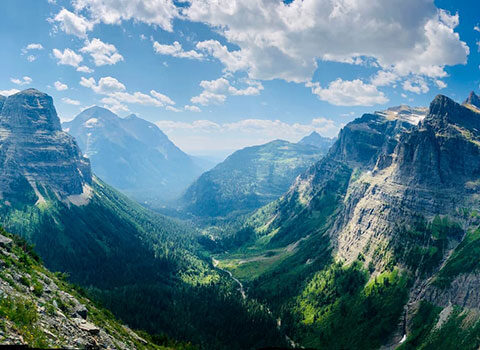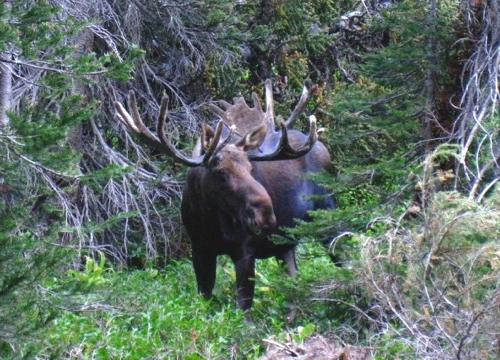Wolverines

Wolverines are constantly on the move. This means they need space, and lots of it. M3, a wolverine who lived primarily in Glacier Park, had a territory of several hundred square miles.
At first glance, wolverines may not seem that exciting. They are a member — the largest member, in fact — of the weasel family, and weasels aren’t the first species you think of when you think “awe-inspiring.”
Let me assure you, wolverines are worth another look.
When I decided to write about wolverines, I started compiling facts, statistics, and the latest research. The more I looked over the info I’d gathered, the more I kept coming back to this:
The essence of a wolverine cannot be summed up by making a list of facts and numbers because the good stuff isn’t in the stats.
Wolverines are surprisingly complex. Just when you think you have them figured out, they throw a curve ball. They are tenacious predators and gentle, playful parents. They are solitary hunters, but sometimes climb mountains with relatives.
I hope you learn from this post, and I really hope you get a little inspiration on how to do life like a wolverine.
Life Lesson 1: Wolverines Ignore the Odds
Wolverines are nature’s underdog. They typically weigh in at around 30 pounds. However, they will fight a full-grown grizzly off of a kill. It’s not uncommon for a wolverine to tunnel 30 feet through densely packed avalanche debris — that’s between 2 1/2 and 3 stories of hard-packed snow, ice, rocks, and broken trees — to get to something they want to eat.
There have been confirmed reports of a single wolverine taking down a full-grown moose. Glacier’s Shiras Moose typically weigh between 600 and 1600 pounds!
For those of you keeping track at home — in terms of weight ratios — that would be like your average house cat deciding to go deer hunting. It’s doubtful a wolverine would go for the healthiest, strongest moose it could find, but it’s still impressive.
Wolverines don’t care that they are small. They don’t back down. They don’t give up. When they win a fight, it isn’t because they are the biggest or the strongest. It’s because they flat out refuse to act their size, pay attention to the odds, or accept defeat.
Life Lesson 2: Wolverines Climb Mountains for Fun. You Should, Too.
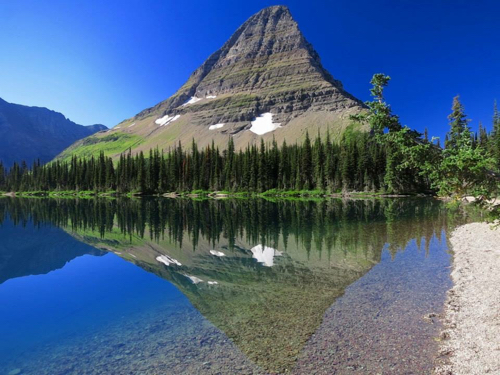
Bearhat Mountain may not look like a daunting climb on a sunny August day, but in early spring, winter still has a firm grip on the high country and can create some pretty extreme conditions . Photo by Glacier Guide Jeff Compton
In the 2004 spring, a wolverine research team flew over Glacier. They hoped to locate the den of a particular female. Her radio signal indicated that they were close, but before her location could be triangulated, the team spotted her from the plane.
She was on the summit of Bearhat Mountain, a steep, solitary, exposed mountain that dramatically protrudes in between Hidden Lake and Avalanche Lake.
There is no explanation for why a wolverine would summit Bearhat in the spring. Nothing a wolverine eats hangs out that high in April. Not to mention that in winter conditions, the top of Glacier peak is pretty much the definition of foreboding.
Maybe she went up there to release her scent, to alert others of her kind that she was in the neighborhood. Even then, she could have chosen an easier vantage point.
After years of living in wolverine territory and hearing stories about them, and after taking in the views from the summit of Bearhat Mountain myself on a perfect bluebird day, I like to think she climbed it in the spirit of George Mallory — because it was there.
And Then There’s M3
The Bearhat gal isn’t the only wolverine known to climb for fun. One especially infamous character around these parts is a wolverine named M3. He made headlines by climbing to the top of Mount Cleveland via the technical south face. Cleveland is the highest peak in the park, and the south face has never been climbed by a human. It rises up 5000 vertical feet from the valley floor!
Even in summer conditions, the south face of Cleveland looks pretty impossible. M3 climbed it in January, and he did it in 90 minutes.
The general reaction among wolverine experts to events like M3’s Cleveland climb is to chuckle, shrug, and chalk it up to the inexplicable character of wolverines.
_Life Lesson 3: Look Out for Your Clan
We know wolverines will fight off grizzly bears and climb rugged mountains. Researchers also know that they are playful, gentle parents.
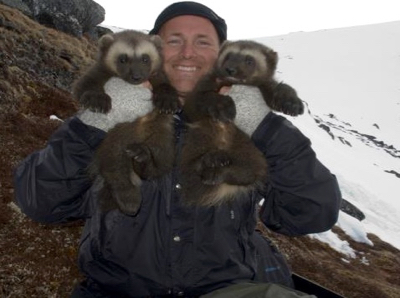
When kits are born, they are pure white. After a couple of weeks they turn gray, and then, at about 7 weeks, they turn dark brown and develop the distinctive stripes that are characteristic of adult wolverines. The kits here are about 8 -9 weeks old. (Authors note: wolverine handling is not a hobby you should consider. For the animals sake, as well as your own, handling wildlife should be left to trained experts, like the man pictured here.) Photo by Rick Yates.
As unlikely as it sounds, wolverines are incredible parents. While it’s common among predators for mothers to be protective, nurturing, and attentive, it’s unusual in males. The latest research done in Glacier turned the previously accepted view of wolverines on its head when it showed, fairly conclusively, that the males play an active role in raising kits. A male wolverine visited his offspring in their den while mom was away. The reason for his visit was, presumably, to protect the kits during their mother’s absence.
Once wolverines are strong enough to venture away from their mothers, they’ve been known to spend time with their fathers. Dad teaches them the lay of the land and how to hunt. There are multiple documented instances of male wolverines allowing their offspring to stay within their own established territory into early adulthood. This extra time under their dad’s protection allows youngsters to gain strength and hone their hunting skills in relative safety.
Family Ties
Related wolverines have also been seen traveling together on many occasions, suggesting that a bond of some kind exists in wolverine families.
Prior to the research done in Glacier, wolverines were generally believed to be solitary, intolerant creatures. Now we know they have complex family structure that we are just beginning to understand. Life in the mountains can be harsh and unforgiving, but wolverines have a better chance of survival because they take care of their own.
_Life Lesson 4: Fearlessly Explore New Horizons
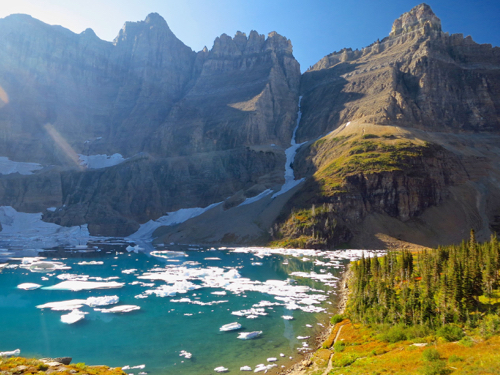
Have you ever gazed at an enormous peak and been inexplicably drawn to explore whatever is on the other side? If so, you have more in common with wolverines than you might think. Photo by Glacier Guide Jeff Compton
You don’t have to talk to someone who’s studied wolverines very long before you figure out that they –the wolverines and the researchers — don’t like to sit still.
They aren’t particularly fast runners, but they steadily cruise around on challenging terrain like it’s flat ground.
With long claws that act as crampons, and a small mass that keeps them from breaking through the top layer of snow, wolverines are built for travel in rugged, snow-covered mountains. What they can do would leave you and me wishing for a warm fire and a dry pair of socks.
More on Mighty M3
The legendary M3 had a territory that encompassed several hundred square miles of rugged terrain. He knew no borders and traveled through Montana, British Columbia, and Alberta. Another male, M8, after being tossed out of his own territory by M3, took off and ended up over 800 miles away, in central British Columbia.
Wolverines aren’t likely to take the safe route when exploring new terrain . Pouring over maps of Glacier superimposed with common routes that wolverines use led me to conclude that wolverines prefer the toughest, gnarliest terrain they can find.
_ _Life Lesson 5: Don’t Do Things Halfway
The latin for wolverine is gulo gulo. Gulo means glutton, and wolverines are serious enough about eating to warrant the use of the word twice. Wolverines are primarily carnivores, but are also opportunists who are unlikely to pass up huckleberries and other enticing vegetation when hungry. Which, with wolverines, is all the time.
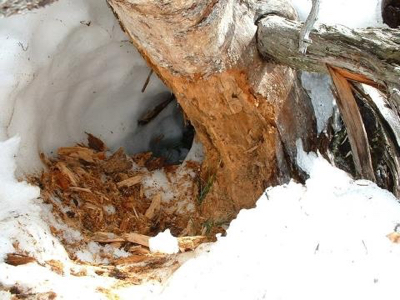
Female wolverines burrow under fallen trees and create natal dens, where they give birth to their kits. After a few weeks, as an additional safety precaution, the kits born in this den were likely moved by their mother to a larger, more elaborate maternal den. Photo by Rick Yates.
In addition to their insatiable appetite, wolverines have dense teeth and strong jaws that are capable of crushing bone. This allows them to consume the nutrient-rich marrow found in bones that other predators have left behind.
Mama Doesn’t Love Halfway, Either
Eating isn’t the area where gulos go all out. The mothers build two dens, even though they don’t hibernate.
When it’s time to give birth, a female tunnels 8-10 feet down in the snow, looking for downed trees or boulders. She builds what is called a reproductive, or natal den. Females especially like the cavernous root structures of White Bark Pines. There is a void underneath that provides an ideal place to give birth.
After a few weeks, the female moves her kits to a larger structure, also under deep snow, called a maternal den. TIn this way, she attempts to elude predators that may have picked up on the scent of the original den.
_Life Lesson 6: Take Care of the Earth
Okay, so technically this isn’t something wolverines spend a lot of energy on, but if they are going to survive as a species, they need us to do it for them.

Scientists in Glacier are keeping a close eye on the rapidly shrinking glaciers. In 1850, there were 150 glaciers in the park. Now, there are 25, and most experts say they will be gone by 2030, if not sooner. Photo by Glacier NPS.
With the current changes that are happening to our climate, most global snow models predict that soon, there will be less snow, particularly in the Continental US. This spells bad news for wolverines, because they need snow and cooler temperatures.
Like bears, wolverines experience delayed implantation. They breed in May and June, but the fertilized eggs don’t implant and turn into a full-blown pregnancy until January.
Kits are born between February and mid-March. Historically, this has been an optimum time to raise young wolverines because the deep snowpack at that time of year provides insulation and security.
Without the protection provided by dens buried deep in the snow, young wolverines would be much more vulnerable to exposure and predation.
As it is, wolverines are slow to reproduce, and a healthy female, with an average lifespan, will likely produce only 5 kits that make it to adulthood. Any changes that slow reproduction any further could be quite detrimental to the species.
Reasons to Love Avalanches
Additionally, avalanches, which are great for the ecosystem in general, are invaluable to scavenging wolverines. Carcasses of unlucky critters that get swept away in avalanches are an important part of the wolverine diet. A warming climate means less snow. Less snow means fewer avalanches, and fewer avalanches could mean food will be harder to find in the winter.
It’s not just warmer weather that’s bad news for gulos. As human development continues to push the boundaries of wild spaces back, travel corridors between viable habitats are threatened.
Protecting Wild Spaces Protects Wolverines
Without the ability to roam from one wild space to another, animals like wolverines are susceptible to population fragmentation. If groups within a species lose their ability to intermix, the population as a whole suffers greatly and is pushed one step closer to extinction.
Wolverines need the beautiful wild places we love even more than we do. They need us to keep working to protect them and the lands they call home.
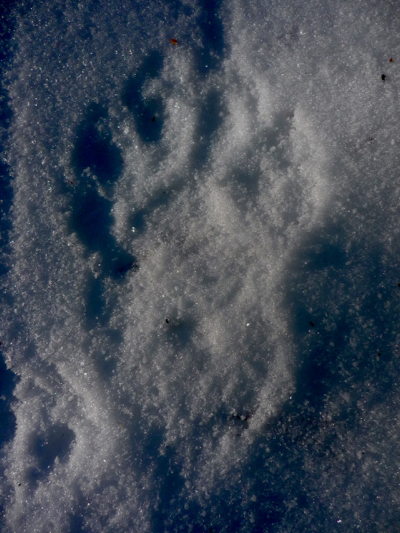
Wolverine tracks are quite unique and therefore easy to spot if you know how to look. Wolverines have huge feet, so keep any eye out for tracks that are 4-5 inches across. Also, because they are a weasel, wolverines have 5 toes, which makes their tracks stand out from others left by critters with similarly sized feet. Photo by Lauren Rivers
Wolverines represent something that’s all too rare in this day and age. They remind us that we need to push the limits, defy the norms, and expand our horizons. It’s a special thing to spend time in wolverine country, and if you haven’t already, I suggest you walk a few miles in their tracks. You won’t regret it.
Author’s Note and Acknowledgements:
Much of the information found in this post came from USFS biologist and wolverine expert Rick Yates. Rick was generous with his photos and knowledge, and patiently answered all the questions I threw at him while writing this blog.
Another source I relied heavily on was The Wolverine Way, by Doug Chadwick. I recommend that you head to your local book store and buy it, read it, then pick up another copy and give it to a friend. Mr. Chadwick doesn’t pay me to sell books, by the way, I just think it’s a great read.

